
Head of Online Medical Content

Audiology Expert

Latest Phonak Hearing Aids 2026
Discover new Phonak hearing aid launches in the UK
What's current? | Predictions for the future | Infinio Ultra hearing aids | Virto Infinio hearing aids | Other notable hearing aids | Key takeaways | Conclusion
Last Hearing Aid UK Update: 02
Overview
If you're researching Phonak hearing aids in 2026, you're looking at relatively straightforward ranges.
Phonak's most recent range centres on the Infinio Ultra family, which features the Sphere model with its dedicated AI chip for speech separation, and the Ultra R with excellent automated technology but without that AI hardware.
These are both alongside the Virto Infinio custom-made models for people who want discreet In-the-Ear options, and other relevant ranges such as the Lumity and Slim.
This article explains what's actually available right now, what might realistically arrive later in 2026, and more importantly, how to work out which model suits your specific situation without overpaying for technology you won't use.
What's currently available from Phonak 2026?
Phonak's latest ranges are built around two main families, which are the Infinio Ultra range with advanced AI technology, and the Virto Infinio custom-made models for people who want discreet In-the-Ear hearing aids.
Here's what you can actually get right now in the Infinio Ultra range:
- Phonak Infinio Ultra Sphere (i90, i70): This is the headline technology and the first hearing aid with a dedicated AI chip specifically for separating speech from background noise.
- Phonak Infinio Ultra R (i90, i70, i50, i30): This includes premium automated performance without the dedicated AI chip. Excellent technology, just without the advanced speech separation hardware.
Both models feature AutoSense OS 7.0, which is 24% more precise than the previous generation at recognising your listening environment and adjusting accordingly.
Here are the current Virto Infinio custom ranges available:
- Phonak Virto Infinio (i90, i70, i50, i30): These are custom-made to fit your ear canal, using advanced biometric calibration.
- Phonak Virto Infinio Titanium (i90, i70): These are the same custom fit, but with a medical-grade titanium shell that's 50% thinner than traditional materials and remarkably discreet.
Established and current Phonak ranges
- Audeo Lumity: Launched in 2022, this range has proven technology with SmartSpeech features and AutoSense OS 5.0.
- Slim: Launched in 2023, this has a unique ergonomic design based on the Lumity platform, ideal for glasses wearers.
- CROS Infinio and CROS Lumity: These are both solutions for single-sided deafness (SSD) individuals who need sound transmitted from their poorer ear to their better ear.
Recently discontinued Phonak ranges
Audeo Infinio and Audeo Infinio Sphere, launched in August 2024, were eventually replaced by the Infinio Ultra range in October 2025.
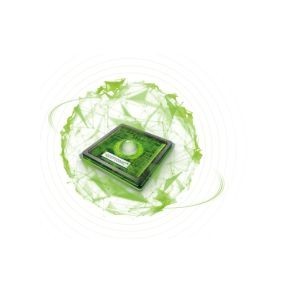
Predictions for Phonak hearing aids in 2026
Based on current technology trends and what Phonak has delivered with the Infinio Ultra range, here's what could realistically happen in 2026
Further AI refinement
The DEEPSONIC chip in the Ultra Sphere hearing aids is genuinely impressive technology, but it's still relatively new.
Expect Phonak to refine how it works and perhaps make it more efficient, improving battery life when using full AI mode, or enhancing how it handles complex listening environments.
Health tracking features
Many hearing aid manufacturers are moving towards health monitoring. Currently, Phonak's aids track steps and activity, but we might see expansion into fall detection, heart rate monitoring, or other health metrics.
Auracast expansion
The Infinio Ultra range is ready for Auracast broadcast technology, which promises to let you connect to public sound systems in cinemas, theatres, or stations. As this technology becomes more widespread in public spaces, expect Phonak to refine how their aids interact with it.
Possible new form factors
Phonak might introduce new wearing styles or designs, particularly for the Ultra R platform. The Slim range (which is still available on the older Lumity platform) showed there's demand for different ergonomic approaches.
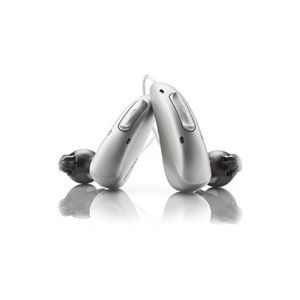
Current Phonak Hearing Aids of 2026
Overview of features and benefits
Latest launch: Phonak Infinio Ultra R hearing aids: Premium without the AI chip
The Ultra R offers sophisticated automated performance using the same AutoSense OS 7.0 technology, enhanced Bluetooth connectivity, and excellent battery life, just without the dedicated AI hardware.
This is genuinely good technology. The automatic environment detection works seamlessly, switching between different sound processing modes as you move from quiet to noisy environments.
The Bluetooth actually works reliably, which is rarer than it should be in hearing aids, and you get impressive battery life.
Available in four technology levels:
i90 - Full feature set, maximum processing channels, all SmartSpeech Technology features enabled
i70 - Reduced feature set, still highly capable
i50 - Mid-range technology, suitable for less demanding listening situations
i30 - Entry-level Infinio platform
The i90 and i70 are the ones worth considering if you want the full benefits of the platform. The i50 and i30 exist, but you're paying for the Infinio name without getting many of its advantages.
►Phonak Infinio Ultra R i90 hearing aids
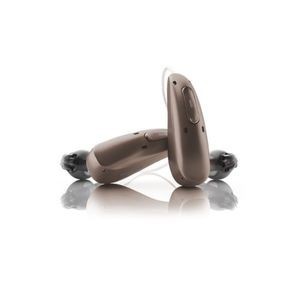
Phonak Infinio Ultra Sphere hearing aids
The Infinio Ultra Sphere isn't just a marketing claim about AI; it genuinely has dedicated hardware that other hearing aids don't have. The DEEPSONIC chip does nothing but work on separating speech from background noise in real-time.
If you're wondering why this matters, traditional hearing aids use directional microphones that focus on what's in front of you.
Clever, but limited, as now the Sphere's AI can extract speech from any direction around you, behind, beside, in front - and handle multiple speakers simultaneously.
Phonak's research suggests you're three times more likely to understand every word in noisy environments compared to not having this technology. That's not a marginal improvement if you regularly struggle in restaurants, pubs, or family gatherings.
Available in only technology levels i90 and i70. However, be honest with yourself about where you struggle. If you rarely go to noisy restaurants or busy social gatherings, you're paying for technology you won't use.
The Sphere is brilliant for people who find themselves frequently in challenging listening environments, but it's overkill for someone who mainly needs help hearing the television at home.
►Phonak Infinio Ultra Sphere i90 hearing aids
2025 brought the launch of Phonak Virto Infinio hearing aids
The Virto Infinio range brings the ERA platform technology to custom-made, In-the-Ear designs. These are moulded specifically to fit your ear canal, so they're as discreet as hearing aids get without being completely invisible.
Your audiologist takes an impression of your ear canal (or uses digital scanning), and the hearing aid is manufactured to precisely fit your ear.
This means better comfort and a more secure fit than universal receivers, but it also means you can't just swap them out if something goes wrong; they're specific to your ears.
Virto Infinio Titanium hearing aids: For people who want invisible
The titanium model uses medical-grade titanium for the shell, which is both ultra-strong and 50% thinner than traditional acrylic. This allows for an even smaller, more discreet fit whilst maintaining durability.
Custom-made In-the-Ear aids sit in your ear canal, which means they're more prone to issues with earwax and moisture. They also can't include some features that Behind-the-Ear models offer, no telecoil option, for instance.
The Titanium models use size 10 batteries, which are the smallest available and might be fiddly if you have poor dexterity.
But if visibility is your primary concern, and you're willing to accept these trade-offs, the Virto Infinio range offers impressive technology in a genuinely discreet package.

►Phonak Infinio Virto i90 hearing aids
►Phonak Infinio Virto Titanium i90 hearing aids

2026 Phonak Hearing Aids
Other notable hearing aid launches
Phonak Slim hearing aids
Phonak Slim hearing aids, launched in May 2023, were an aesthetically streamlined addition to the Lumity platform.
The ergonomic shape (7° angle) of this model is contoured naturally to the curve of your head, leaving more room behind your ears, offering all-day comfort. Ideal for people who wear glasses, oxygen, or a mask, this hearing aid is designed to be seen.
The Slim range remains current in 2026 and continues to be an excellent choice for people who want the unique ergonomic design with proven Lumity technology. Available in performance levels: L90, L70, L50, and L30.
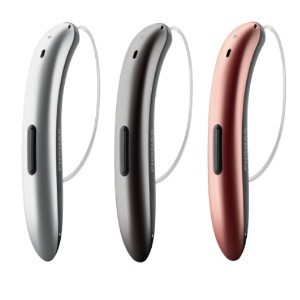
Phonak Audeo Lumity hearing aids
Coming only a few months after their last major product launch and replacing some of those newly released products, this launch was rather unexpected.
These digital hearing aids are very similar in appearance to the previous range, the Phonak Paradise platform. Apart from a few minor features, they are close to identical, and the chip and all of the hardware are the same as what is in Paradise.
Despite the incremental nature of the update at launch, Lumity has proven itself as a reliable, established technology. The Lumity range remains current in 2026 and continues to serve users well with SmartSpeech Technology and AutoSense OS 5.0.
In our opinion, these changes should have just been a free software update to the current Paradise models, rather than being introduced as a new model.
The Phonak Audeo Lumity hearing aids are also designed to adapt to the wearer's listening environment and preferences, resulting in a personalised hearing experience. Available in performance levels: L90, L70, L50, and L30.
The Lumity range includes:
- Audeo Lumity R (standard rechargeable)
- Audeo Lumity -312 (traditional battery)
- Audeo Lumity RT (rechargeable with telecoil)
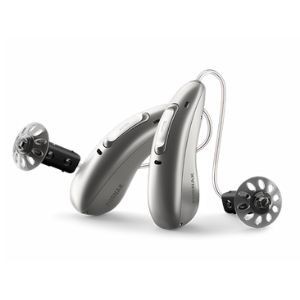
►Phonak Audeo Lumity L90 hearing aids
Key takeaways
✔️ Current Phonak range: Infinio Ultra (Sphere and R models) and Virto Infinio custom models
✔️ The Sphere difference: Dedicated AI chip for speech separation - genuine hardware innovation, not just software
✔️ Ultra R: Excellent automated technology without the AI chip - don't overpay for features you won't use
✔️ Virto Infinio: Custom-made for discretion, but with trade-offs in maintenance and features
✔️ Looking ahead: Expect refinements rather than revolutionary changes in 2026
✔️ Technology levels: i90 offers full features; i70 is capable; i50 and i30 are entry-level
Researching for someone else?
If you're reading this on behalf of a parent, partner, or friend who's struggling with hearing loss, you're doing them a genuine favour by taking the time to understand what's available.
The best next step is booking a consultation with one of our audiologists, either in the clinic or in the comfort of home. You're welcome to attend with them.
Many family members find it helpful to be there for the discussion, and audiologists appreciate having someone who can provide insight into real-world hearing challenges.
There's no obligation, and it's an opportunity to understand what current technology can actually achieve rather than relying on marketing claims.
Conclusion
Phonak's current ranges offers genuinely different options for different needs. The Infinio Ultra Sphere's dedicated AI chip represents real innovation if you regularly struggle in noisy environments.
The Ultra R provides sophisticated performance for people who don't need that cutting-edge technology. And the Virto Infinio models offer discretion for people who prioritise invisibility.
The key is being honest about where you actually struggle with hearing, not choosing technology because it sounds impressive. If you're uncertain which model suits your needs, our audiologists can provide genuinely independent advice based on your specific situation.
Call us free on 0800 567 7621 or complete the form below to speak with one of our hearing specialists about Phonak hearing aids.
Why Choose Us?
- FREE Hearing Tests
- Best Hearing Aids and Prices
- FREE Aftercare for Life
- FREE Home Visits
- 200+ Local Audiologists
- 60 Day Money Back Guarantee
Want more information about the latest Phonak hearing aids of 2026?
Phonak's latest hearing aids, the Infinio range, feature advanced technology for enhanced sound quality and user experience. They offer personalised sound settings, smartphone connectivity, and effective noise cancellation, making them suitable for diverse listening environments.
All models come with rechargeable batteries for convenience and comfort, and users can customise their settings via the myPhonak app.
If you would like any more information about any of the newest Phonak hearing aid ranges please contact us free on 0800 567 7621
Other hearing aid technology articles you might like...
 What hearing aid features do I actually need?
What hearing aid features do I actually need?  Speech Enhancement in Hearing Aids
Speech Enhancement in Hearing Aids  Spatial Awareness in Hearing Aids
Spatial Awareness in Hearing Aids Watch the latest Phonak hearing aids for 2025 in the video below
What's included in our hearing aid prices?
Our specialist service includes:
Do not spend hundreds of pounds without getting a second opinion from us.
Please call us on 0800 567 7621
 Not only are the prices great, but the service is fantastic! Many thanks to your team.
Not only are the prices great, but the service is fantastic! Many thanks to your team.Other pages you might find useful
FAQs
In general, any audiologist will always recommend to you the hearing aid model that best suits your needs. Here is a useful checklist to make sure that is the case.
- Audiologist's level of knowledge: The audiologist you have seen will hopefully have a wide knowledge of all available hearing aids; however, some will only be familiar with a small number of brands and, therefore, may not really be in a position to know which model is the best for you. It is OK to challenge their recommendation and ask them to justify why this particular brand is the one for you.
- Do research: Read about the hearing aid that was recommended. Does it seem like it will suit your lifestyle? Does it have more or fewer features than you need?
- Be aware of sales targets: Many high street retailers have specific tie-ins to a particular manufacturer/brand. The hearing aid they have suggested may still be the correct one for you, but do your research so that you know why they might have recommended it.
If you have significant hearing loss in both ears, you should be wearing two hearing aids. Here are the audiological reasons why:
Localisation: The brain decodes information from both ears and compares and contrasts them. By analysing the minuscule time delays as well as the difference in the loudness of each sound reaching the ears, the person is able to accurately locate a sound source.
Simply put, if you have better hearing on one side than the other, you can't accurately tell what direction sounds are coming from.
Less amplification is required: A phenomenon known as “binaural summation” means that the hearing aids can be set at a lower and more natural volume setting than if you wore only one hearing aid.
Head shadow effect: High frequencies, the part of your hearing that gives clarity and meaning to speech sounds, cannot bend around your head. Only low frequencies can. Therefore, if someone is talking on your unaided side, you are likely to hear that they are speaking, but be unable to tell what they have said.
Noise reduction: The brain has its own built-in noise reduction, which is only really effective when it is receiving information from both ears. If only one ear is aided, even with the best hearing aid in the world, it will be difficult for you to hear in background noise as your brain is trying to retain all of the sounds (including background noise) rather than filtering them out.
Sound quality: We are designed to hear in stereo. Only hearing from one side sounds a lot less natural to us.
Fancy some further reading on this topic? You can read about why two hearing aids are better than one in our article, hearing aids for Both Ears, here
For most people, the main benefit of a rechargeable hearing aid is simple convenience. We are used to plugging in our phones and other devices overnight for them to charge up. Here are some other pros and cons:
For anybody with poor dexterity or issues with their fingers, having a rechargeable aid makes a huge difference, as normal hearing aid batteries are quite small and some people find them fiddly to change.
One downside is that if you forget to charge your hearing aid, then it is a problem that can't be instantly fixed. For most, a 30-minute charge will get you at least two or three hours of hearing, but if you are the type of person who is likely to forget to plug them in regularly, then you're probably better off with standard batteries.
Rechargeable aids are also a little bit bigger and are only available in Behind-the-Ear models.
Finally, just like with a mobile phone, the amount of charge you get on day one is not going to be the same as you get a few years down the line. Be sure to ask what the policy is with the manufacturer's warranty when it comes to replacing the battery.
For most people, the answer is yes. But it's never that simple.
The majority of hearing problems affect the high frequencies a lot more than the low ones. Therefore, open fitting hearing aids sound a lot more natural and ones that block your ears up can make your own voice sound like you are talking with your head in a bucket. Therefore, in-ear aids tend to be less natural.
However, the true answer is we can't tell until we have had a look in your ears to assess the size of your ear canal, and until we have tested your hearing to see which frequencies are being affected.
People with wider ear canals tend to have more flexibility, also there are open fitting modular CIC hearing aids now that do not block your ears.
There is also the age-old rule to consider, that a hearing aid will not help you if it's sat in the drawer gathering dust. If the only hearing aid you would be happy wearing is one that people can't see, then that's what you should get.
Most people can adapt to any type of hearing aid, as long as they know what to expect. Have an honest conversation with your audiologist as to what your needs are.
Generally speaking, six or more. Unless it's none at all. The number of channels a hearing aid has is often a simplistic way an audiologist will use to explain why one hearing aid is better than another, but channels are complex, and it is really not that straightforward. Here are some reasons why:
Hearing aids amplify sounds of different frequencies by different amounts. Most people have lost more high frequencies than low, and therefore need more amplification in the high frequencies. The range of sounds you hear is split into frequency bands or channels, and the hearing aids are set to provide the right amount of hearing at each frequency level.
Less than six channels, and this cannot be done with much accuracy, so six is the magic number. However, a six-channel aid is typically very basic with few other features and is suitable only for hearing a single speaker in a quiet room. The number of channels is not what you should be looking at; it's more the rest of the technology that comes with them.
As a final note, different manufacturers have different approaches. One method is not necessarily better than any other. For example, some manufacturers have as many as 64 channels in their top aids. Most tend to have between 17 and 20. One manufacturer has no channels at all.
Manufacturer's warranties typically last between 2-5 years, depending on the brand and model, and cover defects in materials and workmanship. This includes repairs for component failures, electronic malfunctions, and manufacturing defects, but excludes damage from misuse, accidents, or normal wear. Most manufacturers also include loss and damage insurance for the first year.
We handle all warranty claims on your behalf, liaising with manufacturers and ensuring you get replacement devices quickly when needed. This comprehensive warranty coverage, combined with our lifetime aftercare, gives you complete peace of mind.
Our hearing tests are completely free, whether at our clinics or in your home. Unlike other providers who charge £30-£100 for home visits, we believe hearing healthcare should be accessible without financial barriers. Our comprehensive assessments include examination by a registered audiologist, audiogram results, and personalised recommendations.
All testing, future adjustments, and ongoing support are included at no extra cost. While NHS tests are also free, typical 6-week waiting periods often lead people to seek immediate private testing. We provide prompt, professional assessments that fit your schedule and budget.
Yes, we offer completely free home visits throughout the UK, and this service is included in our prices with no additional charges. Home visits are particularly valuable for people with mobility issues, busy schedules, or those who simply prefer the comfort and convenience of their own environment.
Our audiologists can conduct full hearing tests, fit hearing aids, and provide ongoing support in your home. This service sets us apart from many providers who either don't offer home visits or charge extra for them.
We can offer prices up to 40% lower than high street retailers because of our business model. As a network of 200+ independent audiologists, we don't have the massive overheads of large retail chains - no expensive high street premises, no sales targets pushing audiologists to sell the most expensive options, and no costly marketing campaigns.
However, we maintain the same buying power as the big chains because we purchase on behalf of our entire nationwide network. This means you get access to the same premium hearing aids with professional service, but at genuinely competitive prices.
We offer a comprehensive 60-day money-back guarantee, which gives you twice the industry standard time to properly assess whether your hearing aids are right for you. This extended period recognises that adjusting to hearing aids takes time, and your brain needs several weeks to adapt to the amplified sounds.
Unlike many providers who offer just 30 days, we believe 60 days gives you the confidence to test your hearing aids in all the situations that matter to you - from quiet conversations at home to busy restaurants and outdoor activities.
Ask the Experts
6 Morton Lane
Walkwood
Redditch
Worcestershire
B97 5QA
Latest Launch
When we refer to a product as 'Latest Launch', we mean it is the latest to be released on the market.
New
When we refer to a product as 'New', we mean that the product is the newest hearing aid model on the market.
When we refer to a product as 'Superseded', we mean that there is a newer range available which replaces and improves on this product.
Older Model
When we refer to a product as an 'Older Model', we mean that it is has been superseded by at least two more recent hearing aid ranges.
